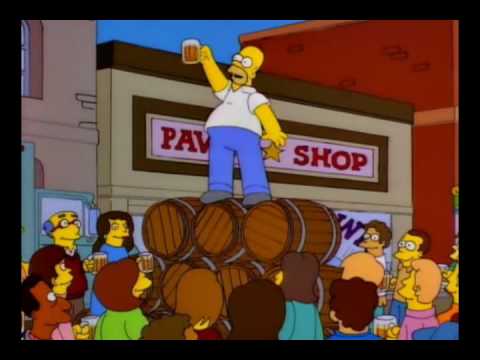
The positive reaction to my World War One Centenary posts has encouraged me to expound upon other topics. But rather than tie all of them in with the Open Threads – because the length of some made scrolling a chore for others – I will make them their own stand-alone posts, allowing me the opportunity to dig deep into topics of interest. This topic is one of those, because there is too much information & discourse to be wedged in-between NFL updates & our quality dick-jokery.
January 16, 1919 – Nebraska ratifies Prohibition.
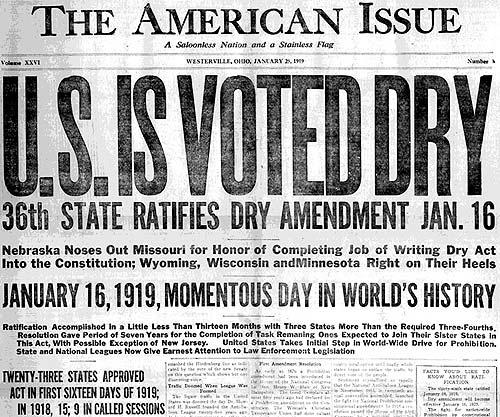
According to Ken Burns, “by 1830, the average American over 15 years old consumed nearly seven gallons of pure alcohol a year – three times as much as we drink today”. It was surmised that there was one saloon – a “retail business selling beer and whiskey by the glass” – for every 150-200 Americans. To increase their market share, the brewers developed “tied houses” in expanding markets – “penetration markets” they called them – in which they set up saloons, financed them, provided signs and advertising paraphernalia, in order to have outlets for their product. In attempt to increase their take from average customers, saloon-keepers were quick to introduce additional enterprises such as gambling and prostitution into their establishments in an attempt to earn profits.
Many Americans considered saloons offensive, noxious institutions, leading in 1893 to the creation of a political interest group calling itself the Anti-Saloon League.
This was the birth of the modern American temperance movement.
If you’re familiar with “The War On Drugs”,
The concept, not these guys.
then you’ve heard how a prohibition movement is supposed to work: 
- first, urge moderation,
- encourage users (drinkers) to help each other to resist temptation, and
- demand that local, state, and national governments prohibit the intoxicant outright.
But politicians don’t listen to nobodies. They will listen to special-interest groups claiming millions of members and an easily observable social trend.
—————————————————–
The Rise of a Single-Issue / Special Interest Political Organization:
The Anti-Saloon League (ASL) was founded by the Reverend Howard Hyde Russell in Oberlin, Ohio in 1893. Born out of the Progressive Era in US politics – the 1890s to 1920s – the ASL was from the social activism wing of the Progressive Era, meaning that they wanted to eliminate the social ills that arose from the USA’s post-Civil War rapid industrialization and the political corruption that benefited from that growth. Many religious groups saw saloons as a power base for politicians and didn’t like the influence brewers & distillers had over local jurisdictions. The ASL was a united front for these religious groups, who were rooted mainly in Protestant evangelicalism of one sort or another. Their motto was, “the Church in action against the saloon”.
Anyway, what set the Anti-Saloon League (ASL) apart from other single-issue pressure groups in the US was that it also operated its own publishing arm – the American Issue Publishing Company – which is used to spread its message. 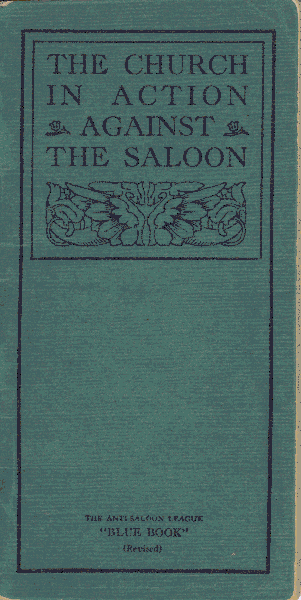 (Their paper provided the headline at the top of this article.) Believing in education over political agitation, the ASL partnered with many churches and gaining endorsement for their activities. In exchange, churches offered up their space for lectures and allowed ASL leaders to speak during church services, and their supplied literature – provided free of charge – was taken home by the parishioners as reinforcement for the sermons. All the ASL asked for in return were small donations to keep their presses operating, and funds to help it spread the message wider. Ernest Cherrington, in writing about the history of the League, said that “the movement was dependent upon the church, first of all, for financial support. It was also dependent upon the church for the necessary influence and power to turn the tide…”
(Their paper provided the headline at the top of this article.) Believing in education over political agitation, the ASL partnered with many churches and gaining endorsement for their activities. In exchange, churches offered up their space for lectures and allowed ASL leaders to speak during church services, and their supplied literature – provided free of charge – was taken home by the parishioners as reinforcement for the sermons. All the ASL asked for in return were small donations to keep their presses operating, and funds to help it spread the message wider. Ernest Cherrington, in writing about the history of the League, said that “the movement was dependent upon the church, first of all, for financial support. It was also dependent upon the church for the necessary influence and power to turn the tide…”
The ASL didn’t form its own party, but rather used its large membership base & national reach to influence politicians to vote their way, using their publishing arm to help bolster support. It opened offices in Washington D.C for the express interest of being able to lobby politicians. Their leader in D.C., Wayne Wheeler, was master at “manipulating majorities through the power of a minority,” and used that power to influence outcomes on the 16th, 18th & 19th Amendments. Historically, it was Wheeler who introduced & originated the term “pressure group” in American politics.
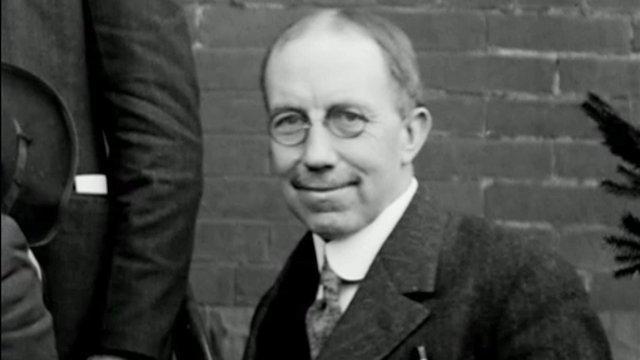
—————————————————–
The Role of Women:
Also important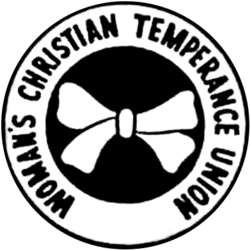 in this cause were allies pushing similar views, which could be aligned into strategic partnerships. The religious temperance movement also became a cradle of the feminist movement. A key ally in the Prohibition movement was the Women’s Suffrage movement. The best known women’s organization favoring Prohibition was the Women’s Christian Temperance Union (WCTU), founded in 1874. The WCTU became a home for women looking to advance the social cause of eliminating alcohol in pursuit of societal salvation, and it replaced the image of the wild-eyed prohibitionists like Carry Nation
in this cause were allies pushing similar views, which could be aligned into strategic partnerships. The religious temperance movement also became a cradle of the feminist movement. A key ally in the Prohibition movement was the Women’s Suffrage movement. The best known women’s organization favoring Prohibition was the Women’s Christian Temperance Union (WCTU), founded in 1874. The WCTU became a home for women looking to advance the social cause of eliminating alcohol in pursuit of societal salvation, and it replaced the image of the wild-eyed prohibitionists like Carry Nation

with what academics called “polished female proto-politicians” like Frances Willard, an important stage in the acquisition of women’s suffrage. By tying prohibition and women’s suffrage together, proponents could easily make the case that it should be both or neither, and if you were against both you were against God and the home.
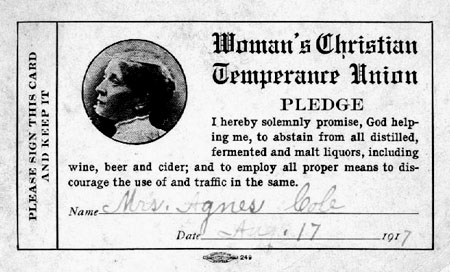
The WCTU also worked to convert immigrants to America into “dry” citizens, meaning that they too would abstain from alcohol. Much of the WCTU’s outreach budget was spent on Ellis Island, in order to achieve this goal. They worked alongside government officials, providing educational “counselling” to new immigrants on how to be “good” Americans, repeating Xenophon’s maxim of “moderation in all things healthful; total abstinence from all things harmful.” Their goal was to help ensure that new Americans were able to leave the ‘antiquated heritage’ of their old society behind and become sober Americans beneficial to their new society. The social revolution that was the suffrage movement would help bring the Prohibition movement to the brink of success.
The downside of this widespread diversification of interests was the dilution of their message. Their core goals were the vote for women, the prohibition of alcohol, and to assist in the assimilation of immigrants into the US “melting pot”. However, these were sometimes lost against other random positions held by various WCTU leaders, ranging from government ownership of utilities to vegetarianism. The advantage the ASL had was adherence to one message: the abolition of alcohol from American life.
—————————————————–
Money, Money, Money:
Tied into this was the nature of government revenues. Alcohol taxes were introduced by the federal government during the Civil War to fund troops & supply, and by the turn of the century counted for 30-40% of all government revenues. By 1910, the US government was collecting over $200 million (unadjusted for inflation) per year from alcohol taxes. Since alcohol taxes were considered “sin taxes”, they were only paid by those who partook in the activity. The tax was mostly paid by the lower classes.
However, a hallmark of the American Progressive Era was the belief that society’s “betters” needed to force change onto the majority because they were either too ill-educated or ill-moraled to know what was good for them. Eliminating liquor was seen to benefit the economy as poorer people would have more money to spend on essentials, strengthening themselves and the home. It was also favoured by American industrialists, because limiting the availability of alcohol gave employers the ability to schedule employees for longer shifts & resulted in fewer missed shifts and workplace accidents. To reduce American dependence on alcohol taxes, prohibitionists allied with trust-busters to propose an “income tax” be added to the US Constitution, in order to allow the government to raise funds from all citizens and wean itself from dependence on the saloons and robber barons of the era to provide sufficient operating revenue.
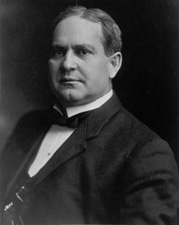
In 1909 Nebraska Senator Norris Brown proposed a Constitutional amendment for an income tax. Congress passed the resolution proposing the tax, and the matter was submitted to the states. Though Republicans protested, by February 3, 1913, the requisite number of states ratified what became the Sixteenth Amendment,
The Congress shall have power to lay and collect taxes on incomes, from whatever source derived, without apportionment among the several States, and without regard to any census or enumeration.
What was needed next was a defining cause that could help rally support around prohibition and demonize the producers of alcohol.
Helping this cause was World War One.
—————————————————–
Xenophobia:
World War I and ambient anti-German hysteria played into the hands of the political organizations that advocated for Prohibition. The beer brewing industry in the United States had long been identified with the industrious German immigrant community, and the majority of beer producers – Anheuser-Busch in St. Louis; Pabst, Miller, and Schlitz of Milwaukee; Sieben Brewery in Chicago – were of German origin. The United States Brewers’ Association’s work with the National German-American Alliance, a political wing of the German immigrant community which spent the first three years of World War I advocating for American neutrality, finally cast the brewers as traitors in the ASL’s propaganda.

By 1917, the German-American Alliance (GAA), an organization with 2.0 million members in the USA, had been identified by ASL spokesman Wayne Wheeler as an organization whose “leaders urge its members to vote only for those who stand for Germanism and oppose Prohibition”. A dry Wisconsin politician named John Strange summarized how the ASL was able to use World War I to attain its final goal: “We have German enemies across the water,” Strange said. “We have German enemies in this country, too. And the worst of all our German enemies, the most treacherous, the most menacing, are Pabst, Schlitz, Blatz and Miller.”

Congressional hearings were held to investigate brewers and their political affiliations, despite hard facts like Anheuser-Busch donating $500,000 to the war effort, and the Milwaukee brewers buying $2.0 million in war bonds. What didn’t help were facts like that same Anheuser-Busch sent $300,000 to Adolphus Busch’s widow so she could provide care for wounded German soldiers, or that they held $500,000 in German war bonds as well. (That they were purchased before the US entered the War mattered little.) Corn Flakes inventor J.H. Kellogg paid for a full-page advertisement attacking brewers in the New York Times on November 3, 1918, repeating British PM David Lloyd George’s declaration that “We are fighting three enemies — Germany, Austria, and Drink.” Promotion of these brewers as “the Kaiser’s fifth column” in America proved too attractive for politicians to ignore. Mobilization of troops provided the League and its allies with a boost in the quest to persuade Americans to support constitutional prohibition. Mobilization called for sacrifice, for supporting the soldiers, and the dry forces quickly capitalized on the patriotic emotions surrounding the war effort.
(It wasn’t all glamorous or pristine: In the South, Prohibitionists stood side by side with racists whose living nightmare was the image of a black man with a bottle in one hand and a ballot in the other, and early leaders of the WCTU made a rationale for Prohibition out of the stereotype that blacks could not hold their liquor. Many suffragists, even some outside the South, argued that white women’s votes were necessary to maintain white supremacy. Many white American women further posited that enfranchising white upper- and middle-class women would counteract black voters.)
Furthering the cause, and promoting their own pro-Americanism, the ASL officially denounced America’s French allies for failing to provide arriving soldiers with pure drinking water, thus leaving them at risk for developing a taste for French wines. They were able to get a number of economists together to argue that alcohol production during the war was unpatriotic, as – for example – the amount of barley used in American beer production could instead make 11 million loaves of bread per day. This allowed the ASL to influence government policy outside of constitutional amendment. The Lever Food and Fuel Control Act of 1917 forbade the manufacture of distilled spirits during the war, legal beer was limited to 2.75% alcohol by weight, and Food Administrator Herbert Hoover reduced the amount of grain available to brewers by 30%.
Further, the amount of industrial resources required to produce & transport alcohol was a burden on the nation’s supply chain during wartime:
The people have been requested to have heatless days, meatless days, wheatless days, but the breweries and saloons of the country continue to waste foodstuffs, fuel and manpower and to impair the efficiency of labour in the mines, factories, and even in munitions plants near which saloons are located. — Wayne Wheeler, President, ASL
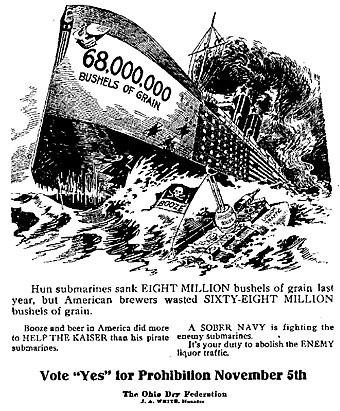

Ohio poster equating alcohol with helping the Germans. The saloonkeeper lamenting his lost customers – loyal soldiers.
—————————————————–
Combining forces:
By aligning the prohibition movement with the suffrage movement, women were able to drum up strong support among the public for women’s right to vote, because the temperance movement both exposed women to politics and exposed women to the effects of their participation in politics. Susan B. Anthony had first become involved in securing the vote for women when she was denied the right to speak at a temperance convention in 1852 in Albany, New York. By 1899, after half a century of suffrage agitation, Anthony attempted to weld her movement to the Prohibition drive. “The only hope of the Anti-Saloon League’s success,” she told an ASL official, “lies in putting the ballot into the hands of women.” Women’s suffrage, the ASL leadership declared, was “the antidote” to the efforts of the beer and liquor interests.
The two forces – the ASL and the WCTU – worked to both support favoured politicians in local elections or to oppose those who were against their cause. Using their combined efforts, these groups successfully backed candidates at the local level, and used that influence to then build on collecting single-issue politicians at the state and federal level. In one three-year stretch in the 1910s, seven Western states adopted Prohibition; not coincidentally, all seven were states where women had achieved the state vote. By 1913, the ASL announced, at it’s 20th anniversary convention, that it was going to pursue a campaign of national prohibition – a “Next and Final Step” the ASL called it. By the 1916 election, these allies had elected enough like-minded politicians to achieve the required 2/3 majority to amend the Constitution and entrench Prohibition. The ASL had made it safe for a candidate or politician to be “dry”. Marrying the 18th & 19th Amendments together was seen to help out both campaigns, and supporters of each helped the other gain both traction and success.
—————————————————–
Political ratification:
On August 1, 1917, the Senate passed a resolution containing the language of the amendment to be presented to the states for ratification. The House of Representatives passed a revised resolution on December 17, 1917. This was then approved by the Senate on December 18, 1917, and the language of the proposed 18th Amendment was then submitted to the states for their ratification.
After one year from the ratification of this article the manufacture, sale, or transportation of intoxicating liquors within, the importation thereof into, or the exportation thereof from the United States and all territory subject to the jurisdiction thereof for beverage purposes is hereby prohibited.
Because the ASL had worked at the state level to ensure prohibition in local communities, the language of the Amendment swiftly made it through many state legislatures. The amendment stipulated a time limit of seven years for the states to pass this amendment. In just 13 months enough states said yes to the amendment that would prohibit the manufacture, sale, and transportation of alcoholic liquors. By January 16, 1919, Nebraska became the 36th state to ratify the Amendment. (North Carolina, Utah, Missouri & Wyoming also ratified on the same day. Telegraph notification proved the time of day the wording was approved, and Nebraska was deemed to have been the 36th state.) Of the 48 states in the US in 1919, only Connecticut & Rhode Island never approved the Amendment.
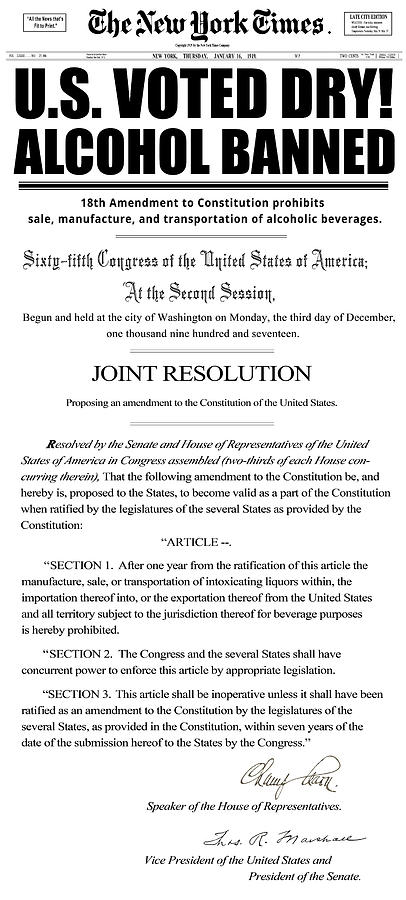
Canada, which has been portrayed in movies as having been the source of much of the illegal alcohol during US prohibition, was actually dry at this time. All provinces declared prohibition (in various forms) under the War Measures Act between 1915-17, and the federal government prohibited inter-provincial trade in liquor in 1918. However, exceptions existed, such as:
- Quebec only banned spirits; beer & wine were okay for sale.
- Ontario allowed the manufacture of spirits & export thereof, but banned intra-provincial sale.
- So it was legal to sell to US gangsters in Canada. The illegal act was them exporting it to the US.
- Parliament eventually passed a law in 1930 that made it illegal to transport alcohol via ship to an American destination.
- So it was legal to sell to US gangsters in Canada. The illegal act was them exporting it to the US.
- Medical exceptions were allowed.
Most Canadian prohibition ended between 1921-27, with the creation of government “liquor boards” to control & regulate the manufacture, import & sale of all alcohols withing that province. These still exist today. The legacy of “rum running” to the US existed from 1924 to 1933 – when most provinces had ended their experiments.

—————————————————–
What next?
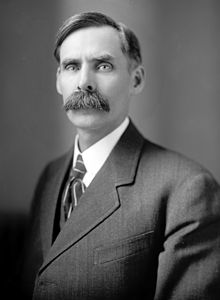
After ratification, the “National Prohibition Act”, taught in History classes as the Volstead Act, named for then-House Judiciary Chairman Andrew Volstead from Minnesota, established the starting date for national prohibition as January 17, 1920, and defined an “intoxicating liquor” as any beverage that contained more than 0.5% alcohol by volume. (In contrast, Canadian prohibition laws set the limit at 2.5 percent.)
Further, it set the three mandates for US Prohibition:
- to prohibit intoxicating beverages,
- to regulate the manufacture, sale, or transport of intoxicating liquor (but not consumption), and
- to ensure an ample supply of alcohol and promote its use in scientific research and in the development of fuel, dye, and other lawful industries and practices, such as religious rituals.
Some of the members of Congress who had voted for the amendment assumed that it referred to hard liquor and would exempt beer and wine. But Wayne Wheeler, the head of the Anti-Saloon League, drafted a tough enforcement act, which followed the tenets of what his organization had been pursuing, not what members of Congress “supposed” would happen.
The 18th Amendment has only 111 words; the Volstead Act had 67 sections and was over 25 pages long. It was confusing. The Act outlined that “no person shall manufacture, sell, barter, transport, import, export, deliver, or furnish any intoxicating liquor except as authorized by this Act”. However, among the technicalities the Act allowed, one could:
- Drink liquor in your own home or in the home of a friend when you are a guest;
- Buy intoxicating liquor on a bona fide medical prescription of a doctor, allowing the purchase of a pint every ten days.
- Consider any place you live permanently as your home.
- If you had more than one home, you could keep a stock of liquor in each.
- Keep liquor in any storage area if it’s for the exclusive use of your family or guests.
- Get a permit to move liquor when you change your residence.
- Manufacture, sell or transport liquor for non-beverage or sacramental purposes provided you obtain a Government permit.
- Wort, or beer that had been halted in the manufacturing process before the yeast was added, was legal for sale. Since wort was sold before it contained alcohol, it was legal and openly sold throughout the country.
- The purchaser added yeast, let the wort ferment, and then filtered it.
Hilariously, it did not prohibit the purchase or consumption of alcohol. Wheeler had assumed that the prohibition of alcohol production made including this facet redundant language. Thus, you were allowed to keep (and drink) liquor you had in your possession as of January 16, 1920. For instance, this codicil enabled the Yale Club in New York to stockpile a supply large enough to last the full 14 years that Prohibition was in force.
—————————————————–
History has taught what the results of prohibition were. I just wanted to identify & research the process that led up to it. Keeping it out of the Open Thread allowed me to pursue greater depth. I hope you enjoyed it.
Wonderful stuff.
VERY FUCKING WELL FUCKING DONE.
Great read.
The Ken Burns Prohibition mini was riveting. The Volstead Act was going too far, but America really seemed like a nation of Uncle Neds back then.
Then again, maybe an Anti Salon League is just what we need these days…
I was a history minor and your write-ups are as good as any professor that I had in five years of college.
If it would’ve taken six, I’d be dead.
The Huns!

Great stuff. Thanks. Another factor in all of this is that beer producers marketed beer as a safe alternative to liquor, so instead of working with distillers, they fought against them, thinking Prohibition wouldn’t go after beer. Brewers actually lobbied “wet” legislators who were opposed to Prohibition to actually vote for it, thinking the law would get rid of their competition and increase their sales. Sort of like being a Log Cabin Republican I suppose.
It’s fascinating to see the convergence of different interests that developed during this movement, because it’s very dissimilar to the political marriages that exist today. Imagine modern conservative Christians taking to the streets in support of a woman’s right to vote!
The power of a wedge issue.
Come on, modern Evangelical voters are much better aligned with depraved philandering racist fearmongers.
I did not know the WWI anti-brewer propaganda angle. Fascinating.
Are you calling Mr. Budweiser a liar, sir?
MMmm. Revisionism.
Man, people with a 40 year life expectancy really knew how to live.
to me, part of this amount is that drinking water was not really available back then So they all drank alcoholic drinks, mainly to kill whatever was in the water, and maybe not as much to forget about life ( or not)
Like we needed another reason to hate Nebraska
One day, I hope to be able to walk into mah Super Target and buy as many Vicuprofen as I want. Just as Prohibition was tossed to the wolves!
/this was an excellent read, and I read every last word
Thank you for cogently capturing the darkest time in our nation’s history.

I found a version not on imgur.

Found a funny:

Go home sportscenter, your drunk….
I’ve said it before and i’ll say it again, I love when you get educational.
Given that, I feel like you stopped at a cliffhanger. I’d love for you to do a followup on what brought about the repeal of prohibition.
Seconded.
If I make it a centenary post, I’ll see you in 2033. By that time, Fozz’s grandkids will be in jail for stabbing Trent Dilfer’s grandkids with Ray Lewis’ grandkid’s knife collection.
I have my theories.
